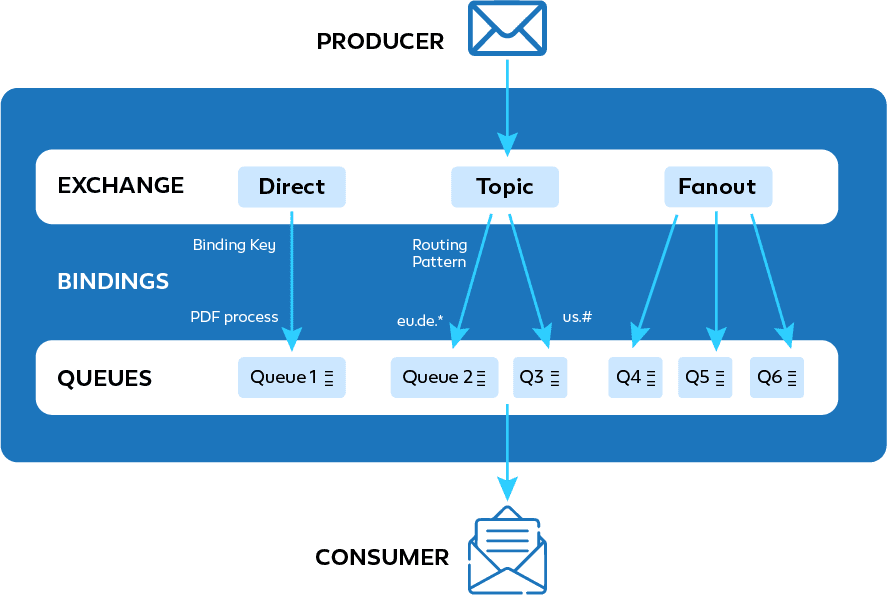- May 30, 2023
- Posted by: Arunkumar P
- Category: Digital Assurance

The Internet of Things (IoT) has grown in technology, enabling the connection of physical devices to the Internet for data exchange and communication. One of the critical challenges in the IoT is managing the vast amounts of data generated by these devices. The Advanced Message Queuing Protocol (AMQP) is a messaging protocol that can help address this challenge by providing reliable, secure, and scalable communication between IoT devices.
Introduction:
AMQP stands for Advanced Message Queuing Protocol, and it is an open standard application layer protocol. AMQP Message Protocol also deals with publishers and subscribers for the consumer.
One of the key features of AMQP is the message broker, which acts as an intermediary between sender and receiver. The broker receives messages from senders, stores them, and delivers them to their intended recipients based on predefined routing rules. The broker provides a range of features such as message persistence, message acknowledgment, and message prioritisation to ensure reliable and efficient message delivery.
Several industries, including telecommunications, healthcare, and financial services, use AMQP. It has been widely adopted as a messaging protocol due to its reliability, interoperability, and flexibility.
Now there are four different exchange types:
- Direct Exchange
- Fan Out Exchange
- Topic Exchange and
- Header Exchange
Direct Exchange:
A direct exchange works by matching the routing key, when there is a match, the message is delivered to the queue. Each message sent to a direct exchange must have a routing key.
If the routing key match, the message can be forwarded to the queue of the message.
For example, suppose there are three nodes named node A, node B, and node C, and a direct exchange named X. If node A is connected to X with a routing key of “key 1”, node B is connected to X with a routing key of “key 2”, and node C is connected to X with a routing key of “key 3”, then when a message is sent to X with a routing key of “key 2”, the message will be routed to node B.
Fan Out Exchange:
A fanout exchange works by sending messages to all of its bound queues. When a message is sent to a fanout exchange, the exchange simply copies it and sends it to all the currently bound queues.
For example, A real-time example of a Fanout Exchange can be a social media platform where a user posts a message that needs to be sent to all the users.
Topic Exchange:
When a message is sent to a topic exchange, the exchange will forward the message to all the queues. If queues have a binding key that matches the routing key, the message is routed to that queue, and finally each customer will receive the message from the queue.
Header Exchange:
A header exchange works by allowing the sender to attach a set of header attributes to each message. The header exchange looks at the headers and compares them to the header values specified in the bindings of each queue. If there is a match between the header of the message and the bindings of a queue, the message is delivered to that queue.
Also read: Internet of Things in the Automotive Industry Blog.
Advantages of AMQP:
Message orientation, queuing, routing (including publish and subscribe and point-to-point), dependability, and security are the characteristics that set AMQP apart.
It employs techniques to ensure the secure transmission of critical data.
Flexibility:
AMQP includes publisher and subscriber request responses among the many message patterns it supports and point-to-point messaging, which makes it suitable for a variety of business use cases.
These services are provided using AMQP:
Healthcare services:
AMQP can be used to transmit medical data from wearable and implantable devices to healthcare providers, enabling remote monitoring and personalised treatment. It can be used to transmit patient data, test results, and other medical information securely and in real time. By using AMQP, healthcare providers can establish a reliable and secure communication channel to exchange data and messages between different services. The transfer of patient information among various healthcare providers, including hospitals, clinics, and laboratories
Financial services:
AMQP can be used to build reliable and secure messaging systems for financial institutions, including stock exchanges, banks, and trading platforms. It can be used to transmit market data, trade orders, and other financial information securely and efficiently. By using AMQP, financial services providers can improve the speed and efficiency of their communication systems and reduce the risk of delays or errors.
Internet of Things (IoT) services:
the AMQP protocol is designed for reliable, interoperable, and secure communication between different components of distributed applications, including Internet of Things (IoT) devices.
Device-to-cloud communication:
The AMQP protocol enables IoT devices to transmit messages to cloud services for further processing and analysis. For instance, a temperature sensor can utilise AMQP to transmit temperature readings to a cloud-based analytics service.
Overall, AMQP provides a flexible and scalable messaging infrastructure that can support various IoT services, from simple device-to-cloud communication to complex event processing and analytics.
Security:
AMQP provides a range of security features, such as authentication and encryption, to protect messages and prevent unauthorised access.
Optimize your IoT data management with AMQP and unlock seamless, secure, and scalable communication between your connected devices. For more details get in touch now
Click here
Conclusion
AMQP is a powerful messaging protocol that enables different applications to communicate with each other reliably, securely, and flexibly. With its client-server architecture and components such as a broker, exchange, queue, producer, and consumer, AMQP provides a robust framework for message-oriented middleware.





